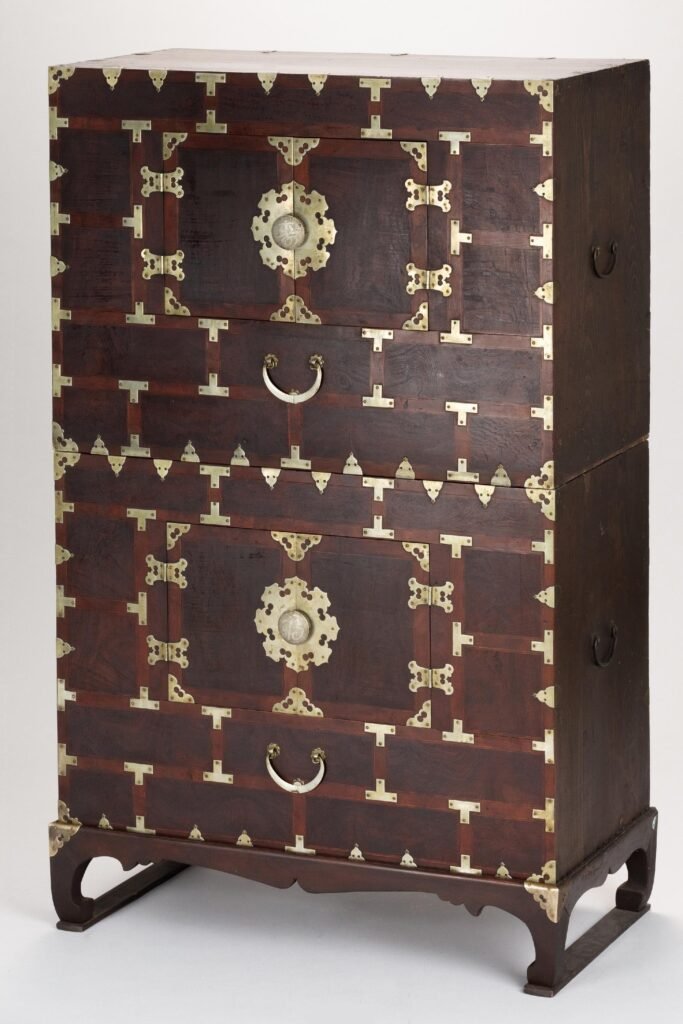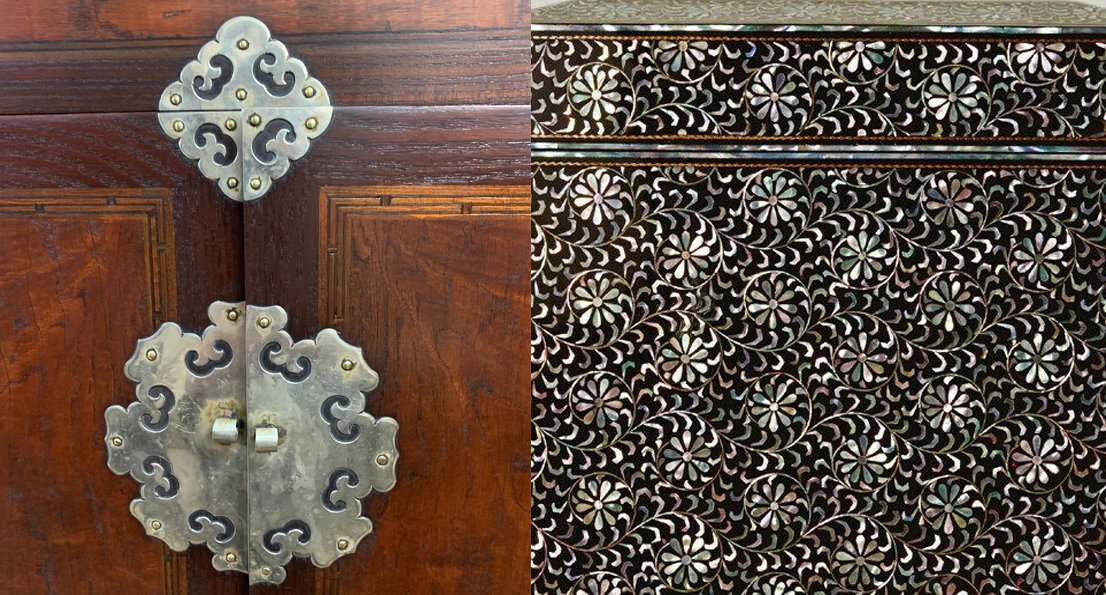Tongyeong (통영) in Korean, is a coastal city in South Gyeongsang Province, South Korea.
Chungmu City and Tongyeong County were reunited in 1995, creating Tongyeong City as it is known today. It was formerly known as Chungmu, named after the posthumous title of Admiral Yi Sun-sin.
Thanks to its location at the southern tip of the peninsula, Tongyeong enjoys favorable conditions. The proximity to the ocean ensured a steady supply of mother-of-pearl, while the climate and environment were conducive to the development of high-quality forest species such as Zelkova.
During the late 20th century, The primary production center for mother-of-pearl furniture in Korea was Tongyeong renowned for its long-standing tradition of crafting the highest quality mother-of-pearl lacquerware.
During the Joseon dynasty (1392–1910) the city was the headquarters of the Korean navy and therefore an important center with a large population compared to other areas in Gyeongsangnam Do province.

MOTHER-OF-PEARL.
Tongyeong is particularly famous for “najeon,” which refers to the mother-of-pearl inlaying technique, as the city is located in the coastal area. For additional information on mother-of-pearl furniture check our special publication: KOREAN MOTHER-OF-PEARL INLAY LACQUER WARE.


Collection: Korean maritime Museum.



H. 116cm, W. 82cm, D. 40,5cm.
The craft of najeonchilgi refers to lacquerware inlaid with nacre (mother-of-pearl), including such items as furniture and accessories.
The surface of the lacquerware is with decorative patterns made by inlaying very thin pieces of nacre (processed from iridescent shells, such as abalone).
Tongyeong, which harvests many abalones, is famous for najeon chilgi nacre-inlaid lacquerware.
This two-tiered chest of lacquer inlaid with mother-of-pearl depicts landscape designs and hexagonal flower patterns (龜甲花文).
Here, the inlay technique involves slicing the nacre into thin thread-like strips and stretching them with the tip of a knife before cutting them off and attaching them to the object.
Collection: National maritime museum of Korea, Busan.


FURNITURE.
As far as the Bandaji is concerned, we invite you to consult the publication: GYEONGSANG DO BANDAJI- 경상도 반닫이
We’ll focus here on a presentation of the “Jangs”, clothing chests, and a particular type of Soban.
Furniture from the Tongyeong area is well known for its particularly fine-grained wood, which was used to build them. Elm and zelkova were predominant species. These woods were widely available in this coastal area.
Particular attention was also paid to the use and manufacture of fine metal parts, often in white brass, which were used not only for their utilitarian function but also for decoration. Various designs of hinges covered the fronts of the furniture. Because of their excessive decoration and the decorative patterns such as flowers, these pieces of furniture were most often placed in the women’s quarters.


1- Rectangular corner piece.
2- Flat rectangular drawer puller.
3- Corner piece.
4- Door fittings. Flower pattern.
5- Corner plate with bat design.
6- Flat rectangular large decorative puller.
7- Corner piece bat design.
8- Decorative plate
9- Central circular lock plate. Moon flower pattern.
10- Flat rectangular large decorative puller.
11- Drawer corner piece.

The Taegeuk pattern The flower on the lock means fortune





ABOVE: Bosang flower pattern on various lock plates.


ABOVE: Rectangular drawer pullers.


ABOVE: Crane design, white brass. Photo right: Central white brass door lock plate, flower pattern. Flower pattern on Jang


Above: Photos detail of fine white brass fittings on a Nong from Tongyeong. Flat drawer puller on small butterfly shaped plates. Bat decorative plate.

Collection: Old story Antique Furniture, Korea.






Photos above: Beautiful patterns and inlay techniques on the front surface are displayed, showcasing Zelkova wood. The bright lines are inlaid with pear wood, while the black lines are made of persimmon wood. The top panel is unique, slightly raised. Metal decorative plates include a total of four bats, two on the top and two on the bottom.


This pair of two-tiered chests was produced in the Tongyeong area of South Gyeongsang Province, as indicated by its front panels and frames smoothed to a plain and even surface, the use of zelkova wood, and various nickel fittings including the butterfly-shaped lock plate.
Although these chests were originally supported to be stacked in two tiers on top of a single
four-legged support, they are now displayed in separately on two such supports.
A subsequent owner apparently modified them by adding a duplicate support.
Collection: The Jordan Schnitzer Museum of Art, University of Oregon.


This chest has the particularity to have an additional row of drawers at the bottom.



Zelkova wood, white brass fittings. legs on both pieces have been added to allow to use the boxes separately.

Private collection.


H. 163cm, W. 78cm, D. 37cm.
Collection: National Folk Museum, Seoul.


Collection: National Folk Museum, Seoul.


H. 140cm, W. 89,5cm, D. 41cm. high.
Private collection.

H.125.1cm, W. 85cm, D. 40cm. Legs missing.
Private collection.

H.134cm, W. 86cm, D. 40cm.
Collection: Old Story Antique Furniture, Korea.



H.139cm, W. 85cm, D. 39cm.
Collection: Old Story Antique Furniture, Korea.





H. 145,5cm, W. 97cm, D. 45,5cm.
Collection: Busan Metropolitan City Museum.


Collection: Tongyeong City Museum.
Gyeongsang Do province.
SOBAN.
Soban made and produced in Tongyeong, Gyeongsangnam-do province. Standard dimensions: H. 25 – 28cm, W. 38 – 47cm, D. 28 – 38cm. Originally, the Tongyeong region is a place with a long history of mother-of-pearl lacquerware, and the amazing skill of mother-of-pearl work extends to small tables, boasting of its excellent craftsmanship. The basic form of the Tongyeong ban is a simple rectangular side and a straight cylindrical four legs without any decoration. While it is rectangular, the shape at the four corners do not form angles but are rolled into two soft curves. The materials used for the top panel include zelkova and ginkgo trees, which have beautiful grain patterns. Linden and pine are also used.



